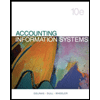
a.
Concept Introduction:
Internal Control: Internal control refers to the ideas, policies, and practices that are established by a business to make sure they monitor risk factors and address them to prevent losses or fraud. Internal controls serve to reduce risks, safeguard assets, and maintain record accuracy.
To state: Whether the given statement is true or false.
b.
Concept Introduction:
Internal Control: Internal control refers to the ideas, policies, and practices that are established by a business to make sure they monitor risk factors and address them to prevent losses or fraud. Internal controls serve to reduce risks, safeguard assets, and maintain record accuracy.
To state: Whether the given statement is true or false.
c.
Concept Introduction:
Internal Control: Internal control refers to the ideas, policies, and practices that are established by a business to make sure they monitor risk factors and address them to prevent losses or fraud. Internal controls serve to reduce risks, safeguard assets, and maintain record accuracy.
To state: Whether the given statement is true or false.
d.
Concept Introduction:
Internal Control: Internal control refers to the ideas, policies, and practices that are established by a business to make sure they monitor risk factors and address them to prevent losses or fraud. Internal controls serve to reduce risks, safeguard assets, and maintain record accuracy.
To state: Whether the given statement is true or false.
Want to see the full answer?
Check out a sample textbook solution
Chapter 6 Solutions
FINANCIAL & MANAGERIAL ACCOUNTING
- D4 ☑✓ fx 10 11 12 14 12345678901234 A B 4 Investment A 5 Investment B 6 Investment C с D E F Growth Rate (Expected) Year 0 Year 1 Formulas 12% $2,200 #N/A 1% $2,200 3% $2,200 #N/A #N/A 8 "Take each value in column C and multiply it by its adjacent growth rate in column B (which is 1 plus the percentage expected growth)." 0) H J K L M N P R ABSOLUTE CELL REFERENCES 13 Investment A Growth Rate (Expected) 12% Year 0 $2,200 Year 1 Year 2 Year 3 Year 4 Year 5 Year 6 Year 7 Year 8 Year 9 Year 10 15 Formulas #N/A #N/A #N/A #N/A #N/A #N/A #N/A #N/A #N/A #N/A 16 17 "Start in column D, then move across allowing the column to change, and multiply the preceding value by its FIXED growth rate in cell $B$13 (which is 1 plus the percentage expected growth) to get the current value." 18 19 FIXED COLUMN / RELATIVE ROW CELL REFERENCES 20 21 22 Investment A 23 Investment B Growth Rate (Expected) Year 0 12% $2,200 1% $2,200 Year 1 Year 2 Year 3 Year 4 Year 5 Year 6 Year 7 Year 8 Year 9 Year 10 24…arrow_forwardI am trying to find the accurate solution to this general accounting problem with the correct explanation.arrow_forwardAnderson Company sells inventory costing $24,000 to a customer for $38,000. Because of significant uncertainties surrounding the transaction, the instalment sales method is viewed as proper. In the first year, the company collects $15,200. In the second year, the company collects another $14,500. What amount of profit should the company recognize in the second year?arrow_forward
- Which of the following is an example of an intangible asset? A) InventoryB) BuildingsC) CopyrightD) Machineryarrow_forwardI need the correct answer to this general accounting problem using the standard accounting approach.arrow_forwardWhat is the first step in the accounting cycle? A) Preparing a trial balanceB) Posting to the ledgerC) Analyzing transactionsD) Preparing financial statementsarrow_forward
- I need help with this general accounting question using the proper accounting approach.arrow_forwardEricsson Company has a predetermined overhead rate of 152% of direct labor cost. Estimated overhead for the period was $275,000. The actual cost for direct labor was $194,000 and the actual overhead was $283,000. How much overhead was applied? How much was over-or under-applied overhead?arrow_forwardGamma Industries, which applies manufacturing overhead on the basis of machine hours, has provided the following data for its most recent year of operations: Item Amount Estimated Manufacturing Overhead $540,000 Estimated Machine Hours 18,000 Actual Manufacturing Overhead $562,500 19,500 Actual Machine Hours The estimates for manufacturing overhead and machine hours were made at the beginning of the year for the purpose of computing the company's predetermined overhead rate for the year. Calculate the overhead rate for the year.arrow_forward
 College Accounting (Book Only): A Career ApproachAccountingISBN:9781337280570Author:Scott, Cathy J.Publisher:South-Western College Pub
College Accounting (Book Only): A Career ApproachAccountingISBN:9781337280570Author:Scott, Cathy J.Publisher:South-Western College Pub Auditing: A Risk Based-Approach (MindTap Course L...AccountingISBN:9781337619455Author:Karla M Johnstone, Audrey A. Gramling, Larry E. RittenbergPublisher:Cengage Learning
Auditing: A Risk Based-Approach (MindTap Course L...AccountingISBN:9781337619455Author:Karla M Johnstone, Audrey A. Gramling, Larry E. RittenbergPublisher:Cengage Learning Auditing: A Risk Based-Approach to Conducting a Q...AccountingISBN:9781305080577Author:Karla M Johnstone, Audrey A. Gramling, Larry E. RittenbergPublisher:South-Western College Pub
Auditing: A Risk Based-Approach to Conducting a Q...AccountingISBN:9781305080577Author:Karla M Johnstone, Audrey A. Gramling, Larry E. RittenbergPublisher:South-Western College Pub- Principles of Accounting Volume 1AccountingISBN:9781947172685Author:OpenStaxPublisher:OpenStax College
 Pkg Acc Infor Systems MS VISIO CDFinanceISBN:9781133935940Author:Ulric J. GelinasPublisher:CENGAGE L
Pkg Acc Infor Systems MS VISIO CDFinanceISBN:9781133935940Author:Ulric J. GelinasPublisher:CENGAGE L Survey of Accounting (Accounting I)AccountingISBN:9781305961883Author:Carl WarrenPublisher:Cengage Learning
Survey of Accounting (Accounting I)AccountingISBN:9781305961883Author:Carl WarrenPublisher:Cengage Learning





